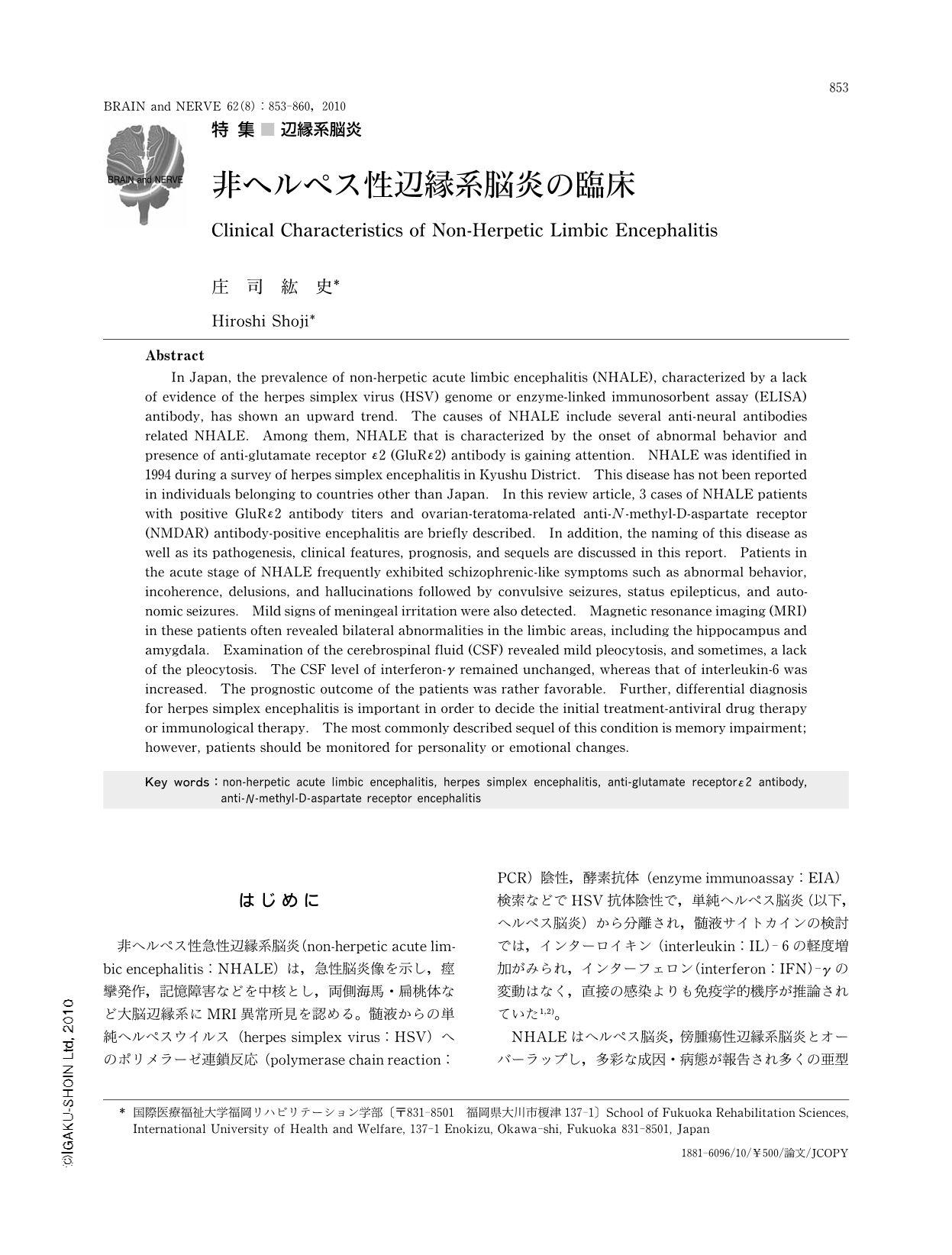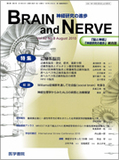Japanese
English
- 有料閲覧
- Abstract 文献概要
- 1ページ目 Look Inside
- 参考文献 Reference
はじめに
非ヘルペス性急性辺縁系脳炎(non-herpetic acute limbic encephalitis:NHALE)は,急性脳炎像を示し,痙攣発作,記憶障害などを中核とし,両側海馬・扁桃体など大脳辺縁系にMRI異常所見を認める。髄液からの単純ヘルペスウイルス(herpes simplex virus:HSV)へのポリメラーゼ連鎖反応(polymerase chain reaction:PCR)陰性,酵素抗体(enzyme immunoassay:EIA)検索などでHSV抗体陰性で,単純ヘルペス脳炎(以下,ヘルペス脳炎)から分離され,髄液サイトカインの検討では,インターロイキン(interleukin:IL)-6の軽度増加がみられ,インターフェロン(interferon:IFN)-γの変動はなく,直接の感染よりも免疫学的機序が推論されていた1,2)。
NHALEはヘルペス脳炎,傍腫瘍性辺縁系脳炎とオーバーラップし,多彩な成因・病態が報告され多くの亜型群を形成しているが(Table1),抗グルタミン酸受容体ε2サブユニット(glutamate receptor ε2:GluRε2)抗体,抗N-メチル-D-アスパラギン酸(N-methyl-D-aspartate:NMDA)受容体抗体,抗電位依存性カリウムチャネル(voltage-gated potassium channel:VGKC)抗体など辺縁系脳炎・脳症の主要な病態に絡む抗神経抗体が検出され,自己免疫機序を巡って活発な展開をみている3-5)。
今回,3例の近縁の疾患(NHALE,抗NMDA受容体脳炎)を評価する機会を得たので概略6)を記載し,最近の知見を中心にNHALEの変遷・病態,臨床,後遺症などに関し言及したい。
Abstract
In Japan,the prevalence of non-herpetic acute limbic encephalitis (NHALE),characterized by a lack of evidence of the herpes simplex virus (HSV) genome or enzyme-linked immunosorbent assay (ELISA) antibody,has shown an upward trend. The causes of NHALE include several anti-neural antibodies related NHALE. Among them,NHALE that is characterized by the onset of abnormal behavior and presence of anti-glutamate receptor ε2 (GluRε2) antibody is gaining attention. NHALE was identified in 1994 during a survey of herpes simplex encephalitis in Kyushu District. This disease has not been reported in individuals belonging to countries other than Japan. In this review article,3 cases of NHALE patients with positive GluRε2 antibody titers and ovarian-teratoma-related anti-N-methyl-D-aspartate receptor (NMDAR) antibody-positive encephalitis are briefly described. In addition,the naming of this disease as well as its pathogenesis,clinical features,prognosis,and sequels are discussed in this report. Patients in the acute stage of NHALE frequently exhibited schizophrenic-like symptoms such as abnormal behavior,incoherence,delusions,and hallucinations followed by convulsive seizures,status epilepticus,and autonomic seizures. Mild signs of meningeal irritation were also detected. Magnetic resonance imaging (MRI) in these patients often revealed bilateral abnormalities in the limbic areas,including the hippocampus and amygdala. Examination of the cerebrospinal fluid (CSF) revealed mild pleocytosis,and sometimes,a lack of the pleocytosis. The CSF level of interferon-γ remained unchanged,whereas that of interleukin-6 was increased. The prognostic outcome of the patients was rather favorable. Further,differential diagnosis for herpes simplex encephalitis is important in order to decide the initial treatment-antiviral drug therapy or immunological therapy. The most commonly described sequel of this condition is memory impairment; however,patients should be monitored for personality or emotional changes.

Copyright © 2010, Igaku-Shoin Ltd. All rights reserved.


